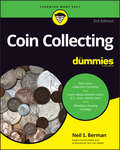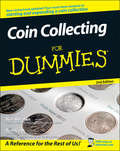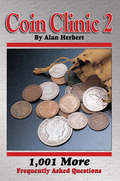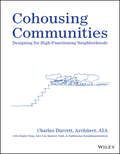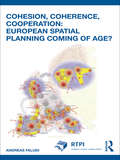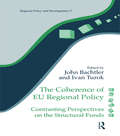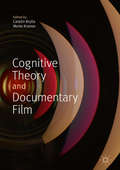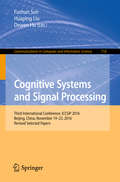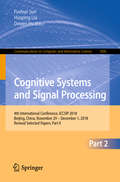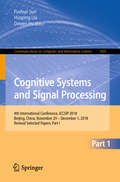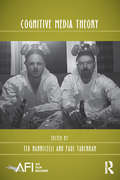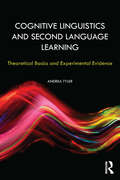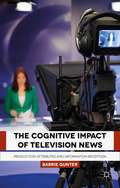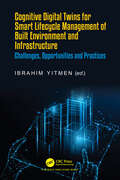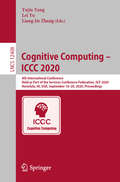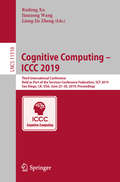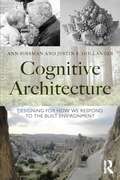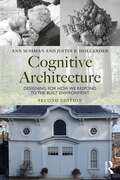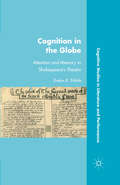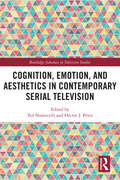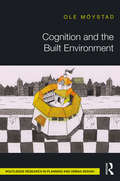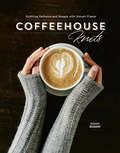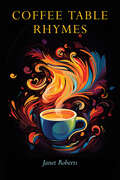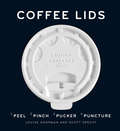- Table View
- List View
Coin Collecting (Merit Badge Series)
by Boy Scouts of AmericaBoy Scouts of America Merit Badge Series pamphlet for the Coin Collecting merit badge.
Coin Collecting For Dummies
by Neil S. BermanDiscover a new hobby—or refine your existing techniques—with this practical coin collecting handbook In Coin Collecting For Dummies, professional rare coin dealer Neil Berman delivers a hands-on and fun guide to the intriguing hobby of numismatics—also known as coin collection! You'll learn how to buy, sell, grade, value, handle, and store your coins, as well as how to decide what kind of coins you should collect and how to assemble or diversify your collection. In this book, you'll also find out how to: Evaluate coins based on their age, condition, rarity, and more Navigate and make use of auction houses that deal in the buying and selling of rare coins Make the most of your new hobby by learning where to find rare coins and how to complete your collections There's no one "right" way to collect coins. But Coin Collecting For Dummies will show you how to avoid the most common pitfalls and take advantage of some handy tips, tricks, and best practices that make collecting coins even more fun and exciting. Perfect for the novice collector, or seasoned veterans looking for the latest news in coin grading and history, this book is a must-read for anyone interested in the fascinating world of coin collection.
Coin Collecting For Dummies
by Neil S. Berman Ron GuthCan't make heads or tails out of coin collecting? You need Coin Collecting For Dummies, 2nd Edition, the treasure trove on information on numismatics. This hands-on guide escorts you through the world's oldest hobby, helping you decide which type of coins you want to collect, keep your collection in mint condition, buy and sell coins on the Internet, find interesting coin shows to attend, and assemble and diversify a great collection.The purpose of this fun, easy-to-access guide is to turn you into a world-class coin collector in as little time as possible. You'll learn what coins can teach you about history and geography, develop organizational and observational skills, and learn to use analytical tools, all without event thinking about it. And you'll learn the basics about ancient coins, U.S. coins, world coins, and the wild-and-wooly stuff that really gets your numismatic juices flowing. Discover how to:Start your collection correctlyEvaluate coins using age, condition, rarity, and moreBuy interesting coins without breaking the bankLocate rare and expensive coinsGet savvy about avoiding fakesGet the whole family involved in your collectionDevelop a buying strategyClean and handle coins safelyKeep your collection secure at home and on the roadInvestigate tokens, medals, and miscellaneous coinsCreate complete collections of copper, nickel, silver, or gold U.S. coinsWhen it comes to numismatics, Coin Collecting For Dummies, 2nd Edition is right on the money!
Coin Clinic 2: 1,001 More Frequently Asked Questions
by Alan HerbertIn the second edition of this popular book, world famous numismatist Alan Herbert returns to answer 1,001 questions, from the routine to the exotic, from collectors, dealers, scholars and anyone curious about money. Drawing from his popular "Coin Clinic" column published in Numismatic News and Coins magazine, Herbert's answers are concise, informative - and always spot on! Whether a novice or an experienced collector, this fascinating book will save the reader from making expensive mistakes when buying and selling coins and paper money, and answers are loaded with reliable information to enhance and reinforce the reader's knowledge of numismatics.
Cohousing Communities: Designing for High-Functioning Neighborhoods
by Charles DurrettCohousing Communities Explore a groundbreaking and holistic new approach to designing community-first neighborhoods In Cohousing Communities: Designing for High-Functioning Neighborhoods, distinguished architect and affordable housing advocate Charles Durrett delivers a complete, start-to-finish guide for designing anything where the emphasis lies with the community. This book describes the consequential role that architecture and a healthy design process can play in the success of neighborhoods, churches, towns, and more. It’s an inspiring collection of ideas that prioritize high-functioning neighborhoods. In the book, the author draws on the success of hundreds of community-first projects to show readers how to design a project that addresses both timeless and modern challenges—from aging to climate change and racism—in its architecture and urban design. He compiles facts and concepts that are essential to the design of a high-functioning community, where people can participate in a way that reflects their values, improves their social connections, and retain their autonomy and privacy. Readers will also find: Ideas for town planning, street planning, and other town altering improvements Discussions of how developers can make better multifamily housing Explorations of how planners and politicians can make high-functioning neighborhoods a cornerstone of their community In-depth treatments of families who want to confirm that they’re choosing the right neighborhood Perfect for university students and professors who strive to see new ways to create neighborhoods, Cohousing Communities: Designing for High-Functioning Neighborhoods will also appeal to universities planning new neighborhoods for retired alumni or new housing for students and faculty.
Cohesion, Coherence, Cooperation: European Spatial Planning Coming Of Age? (RTPI Library Series)
by Andreas FaludiSince its foundation the European Union has gradually developed policies that are aimed at achieving increased economic and social cohesion. This book examines the most recent of these, the concept of territorial cohesion. Territorial cohesion is the pursuit of balanced development, competitiveness, sustainable development, and good governance. These concerns are most readily addressed by the formulation of spatial strategies under the umbrella of spatial planning, that brings together a multitude of public and private actors in a process that requires cohesion, coherence and co-operation. This book traces the development of spatial planning at European level and argues that spatial planning can become a vehicle, not only for territorial cohesion, but for EU policy generally.
The Coherence of EU Regional Policy: Contrasting Perspectives on the Structural Funds (Regions and Cities #Vol. 16)
by John Bachtler Ivan TurokThis book brings together a rich selection of up-to-date practical experience of EU regional policy from across Europe. It provides different perspectives on the design and operation of regional development strategies under the Structural Funds, from people closely involved in studying, managing or advising on the process at EU, national and regional levels. It therefore offers a more comprehensive and detailed understanding of the structural policies than has been available hitherto. This will prove particularly useful to researchers, practitioners and students interested in European regional policies and processes.
Cognitive Theory and Documentary Film
by Catalin Brylla Mette KramerThis groundbreaking edited collection is the first major study to explore the intersection between cognitive theory and documentary film studies, focusing on a variety of formats, such as first-person, wildlife, animated and slow TV documentary, as well as docudrama and web videos. Documentaries play an increasingly significant role in informing our cognitive and emotional understanding of today’s mass-mediated society, and this collection seeks to illuminate their production, exhibition, and reception. Taking an interdisciplinary approach, the essays draw on the latest research in film studies, the neurosciences, cultural studies, cognitive psychology, social psychology, and the philosophy of mind. With a foreword by documentary studies pioneer Bill Nichols and contributions from both theorists and practitioners, this volume firmly demonstrates that cognitive theory represents a valuable tool not only for film scholars but also for filmmakers and practice-led researchers.
Cognitive Systems and Signal Processing: Third International Conference, ICCSIP 2016, Beijing, China, November 19–23, 2016, Revised Selected Papers (Communications in Computer and Information Science #710)
by Huaping Liu Fuchun Sun Dewen HuThis book constitutes the refereed proceedings of the Third International Conference on Cognitive Systems and Signal Processing, ICCSIP2016, held in Beijing, China, in December 2016. The 59 revised full papers presented were carefully reviewed and selected from 171 submissions. The papers are organized in topical sections on Control and Decision; Image and Video; Machine Learning; Robotics; Cognitive System; Cognitive Signal Processing.
Cognitive Systems and Signal Processing: 4th International Conference, ICCSIP 2018, Beijing, China, November 29 - December 1, 2018, Revised Selected Papers, Part II (Communications in Computer and Information Science #1006)
by Fuchun Sun Huaping Liu Dewen HuThis two-volume set (CCIS 1005 and CCIS 1006) constitutes the refereed proceedings of the 4th International Conference on Cognitive Systems and Signal Processing, ICCSIP2018, held in Beijing, China, in November and December 2018.The 96 revised full papers presented were carefully reviewed and selected from 169 submissions. The papers are organized in topical sections on vision and image; algorithms; robotics; human-computer interaction; deep learning; information processing and automatic driving.
Cognitive Systems and Signal Processing: 4th International Conference, ICCSIP 2018, Beijing, China, November 29 - December 1, 2018, Revised Selected Papers, Part I (Communications in Computer and Information Science #1005)
by Fuchun Sun Huaping Liu Dewen HuThis two-volume set (CCIS 1005 and CCIS 1006) constitutes the refereed proceedings of the 4th International Conference on Cognitive Systems and Signal Processing, ICCSIP2018, held in Beijing, China, in November and December 2018.The 96 revised full papers presented were carefully reviewed and selected from 169 submissions. The papers are organized in topical sections on vision and image; algorithms; robotics; human-computer interaction; deep learning; information processing and automatic driving.
Cognitive Media Theory (AFI Film Readers)
by Ted Nannicelli Paul TaberhamAcross the academy, scholars are debating the question of what bearing scientific inquiry has upon the humanities. The latest addition to the AFI Film Readers series, Cognitive Media Theory takes up this question in the context of film and media studies. This collection of essays by internationally recognized researchers in film and media studies, psychology, and philosophy offers film and media scholars and advanced students an introduction to contemporary cognitive media theory—an approach to the study of diverse media forms and content that draws upon both the methods and explanations of the sciences and the humanities. Exploring topics that range from color perception to the moral appraisal of characters to our interactive engagement with videogames, Cognitive Media Theory showcases the richness and diversity of cognitivist research. This volume will be of interest not only to students and scholars of film and media, but to anyone interested in the possibility of a productive relationship between the sciences and humanities.
Cognitive Linguistics and Second Language Learning: Theoretical Basics and Experimental Evidence (Second Language Acquisition Research Series)
by Andrea TylerThis book illustrates the ways that cognitive linguistics, a relatively new paradigm in language studies, can illuminate and facilitate language research and teaching. The first part of the book introduces the basics of cognitive linguistic theory in a way that is geared toward second language teachers and researchers. The second part of the book provides experimental evidence of the usefulness of applying cognitive linguistics to the teaching of English. Included is a thorough review of the existing literature on cognitive linguistic applications to teaching and cognitive linguistic-based experiments. Three chapters report original experiments which focus on teaching modals, prepositions and syntactic constructions, elements of English that learners tend to find challenging. A chapter on “future directions” reports on an innovative analysis of English conditionals. Pedagogical aids such as diagrams and sample exercises round out this pioneering and innovative text.
The Cognitive Impact of Television News
by Barrie GunterResearch shows that, while people around the world consistently nominate television as their most important news source, much of the content of news bulletins is lost to viewers within moments. In response, Barrie Gunter argues that this can be explained by the way in which televised news is written, packaged and presented.
Cognitive Digital Twins for Smart Lifecycle Management of Built Environment and Infrastructure: Challenges, Opportunities and Practices
by Ibrahim YitmenThis book provides knowledge into Cognitive Digital Twins for smart lifecycle management of built environment and infrastructure focusing on challenges and opportunities. It focuses on the challenges and opportunities of data-driven cognitive systems by integrating the heterogeneous data from multiple resources that can easily be used in a machine learning model and adjust the algorithms. It comprises Digital Twins incorporating cognitive features that will enable sensing complex and unpredicted behavior and reason about dynamic strategies for process optimization to support decision-making in lifecycle management of the built environment and infrastructure. The book introduces the Knowledge Graph (KG)-centric framework for Cognitive Digital Twins involving process modeling and simulation, ontology-based Knowledge Graph, analytics for process optimizations, and interfaces for data operability. It offers contributions of Cognitive Digital Twins for the integration of IoT, Big data, AI, smart sensors, machine learning and communication technologies, all connected to a novel paradigm of self-learning hybrid models with proactive cognitive capabilities. The book presents the topologies of models described for autonomous real time interpretation and decision-making support of complex system development based on Cognitive Digital Twins with applications in critical domains such as maintenance of complex engineering assets in built environment and infrastructure. It offers the essential material to enlighten pertinent research communities of the state-of-the-art research and the latest development in the area of Cognitive Digital Twins, as well as a valuable reference for planners, designers, developers, and ICT experts who are working towards the development and implementation of autonomous Cognitive IoT based on big data analytics and context–aware computing.
Cognitive Computing – ICCC 2020: 4th International Conference, Held as Part of the Services Conference Federation, SCF 2020, Honolulu, HI, USA, September 18-20, 2020, Proceedings (Lecture Notes in Computer Science #12408)
by Yujiu Yang Lei Yu Liang-Jie ZhangThis book constitutes the proceedings of the International Conference on Cognitive Computing, ICCC 2020, held as part of SCF 2020 in Honolulu, HI, USA, in September 2020.The conference was held virtually due to the COVID-19 pandemic. The 8 full and 2 short papers presented in this volume were carefully reviewed and selected from 20 submissions. The papers cover all aspects of Sensing Intelligence (SIJ as a Service (SlaaS). Cognitive Computing is a sensing-driven computing (SDC) scheme that explores and integrates intelligence from all types of senses in various scenarios and solution contexts.
Cognitive Computing – ICCC 2019: Third International Conference, Held as Part of the Services Conference Federation, SCF 2019, San Diego, CA, USA, June 25–30, 2019, Proceedings (Lecture Notes in Computer Science #11518)
by Ruifeng Xu Jianzong Wang Liang-Jie ZhangThis book constitutes the proceedings of the International Conference on Cognitive Computing, ICCC 2019, held as part of SCF 2019, in San Diego, CA, USA, in June 2019. The 14 full and 3 short papers presented in this volume were carefully reviewed and selected from 42 submissions. The papers cover all aspects of Sensing Intelligence (SIJ as a Service (SlaaS). Cognitive Computing is a sensing-driven computing (SDC) scheme that explores and integrates intelligence from all types of senses in various scenarios and solution contexts
Cognitive Architecture: Designing for How We Respond to the Built Environment
by Ann Sussman Justin B Hollander*Winner of the Environmental Design Research Association 2016 Place Research Award!* In Cognitive Architecture, the authors review new findings in psychology and neuroscience to help architects and planners better understand their clients as the sophisticated mammals they are, arriving in the world with built-in responses to the environment that have evolved over millennia. The book outlines four main principles---Edges Matter, the fact people are a thigmotactic or a 'wall-hugging' species; Patterns Matter, how we are visually-oriented; Shapes Carry Weight, how our preference for bilateral symmetrical forms is biological; and finally, Storytelling is Key, how our narrative proclivities, unique to our species, play a role in successful place-making. The book takes an inside-out approach to design, arguing that the more we understand human behavior, the better we can design for it. The text suggests new ways to analyze current designs before they are built, allowing the designer to anticipate a user's future experience. More than one hundred photographs and drawings illustrate its key concepts. Six exercises and additional case studies suggest particular topics - from the significance of face-processing in the human brain to our fascination with fractals - for further study.
Cognitive Architecture: Designing for How We Respond to the Built Environment
by Ann Sussman Justin B HollanderIn this expanded second edition of Cognitive Architecture, the authors review new findings in psychology and neuroscience to help architects and planners better understand their clients as the sophisticated mammals they are, arriving in the world with built-in responses to the environment. Discussing key biometric tools to help designers ‘see’ subliminal human behaviors and suggesting new ways to analyze designs before they are built, this new edition brings readers up-to-date on scientific tools relevant for assessing architecture and the human experience of the built environment. The new edition includes: Over 100 full color photographs and drawings to illustrate key concepts. A new chapter on using biometrics to understand the human experience of place. A conclusion describing how the book’s propositions reframe the history of modern architecture. A compelling read for students, professionals, and the general public, Cognitive Architecture takes an inside-out approach to design, arguing that the more we understand human behavior, the better we can design and plan for it.
Cognition in the Globe: Attention and Memory in Shakespeare’s Theatre (Cognitive Studies in Literature and Performance)
by Evelyn B. TribbleEarly modern playing companies performed up to six different plays a week and mounted new plays frequently. This book seeks to answer a seemingly simple question: how did they do it? Drawing upon work in philosophy and the cognitive sciences, it proposes that the cognitive work of theatre is distributed across body, brain, and world.
Cognition, Emotion, and Aesthetics in Contemporary Serial Television (Routledge Advances in Television Studies)
by Ted Nannicelli and Héctor J. PérezThis book posits an interconnection between the ways in which contemporary television serials cue cognitive operations, solicit emotional responses, and elicit aesthetic appreciation. The chapters explore a number of questions including: How do the particularities of form and style in contemporary serial television engage us cognitively, emotionally, and aesthetically? How do they foster cognitive and emotional effects such as feeling suspense, anticipation, surprise, satisfaction, and disappointment? Why and how do we value some serials while disliking others? What is it about the particularities of serial television form and style, in conjunction with our common cognitive, emotional, and aesthetic capacities, that accounts for serial television’s cognitive, socio-political, and aesthetic value, and its current ubiquity in popular culture? This book will appeal to postgraduates and scholars working in television studies as well as film studies, cognitive media theory, media psychology, and the philosophy of art.
Cognition and the Built Environment
by Ole MöystadCognition and the Built Environment argues that interacting with our built environment, as users and as architects, is a cognitive process. It claims that architecture, in its form and meaning, is a basic, embodied level of human cognition. The assumption is that we and our built environment together form an intelligent system, a cognitive feedback loop between us and the world of which we are part. With this as a vantage point, the book discusses the meaning and intelligence of concrete architectural environments as well as the agency of the architect, of his client and of the user. The inquiry oscillates between abstract thought, topological models and cognitive semiotics, between pragmatist philosophy and the professional practice of planning cities, developing projects and using objects. Architecture serves more complex purposes than our caves, paths and landmarks did. Written for students and academics of urban design, urban planning and architectural theory, Cognition and the Built Environment argues that human cognition feeds on the interaction between thought, agency and built environment, and that architecture is the spatial form of this interaction.
Coffeehouse Knits: Knitting Patterns and Essays with Robust Flavor
by Kerry BogertThe jolt of inspiration every knitter needs! Inspired by the ritual of sipping and stitching, Coffeehouse Knits is a stimulating collection of knitwear with an extra shot of something special. Whether you're joining friends at the coffee shop for community knitting or you're home enjoying the first cup of the day, perk up your knitting with: 20 patterns that range in skill level from advanced beginner to intermediate--macchiato to espresso.Simple touches evoke the idea of everyone's favorite drink, from steaming swirls around a sweater yoke to coffee bean inspired motifs.Stirring essays from knitters explore community, connection, and caffeine.Pour yourself another cup and settle in with Coffeehouse Knits.
Coffee Table Rhymes
by Janet Roberts“My sister cleans her bedroom In twenty seconds flat. She sweeps the dirt into a pile Then underneath the mat.” A selection of comic verse on such subjects as fraught relationships, untrustworthy professionals, quirky pets and even quirkier family members. Nothing too dark or serious here, just a set of cleverly written, instantly quotable epigrams, along with a handful of longer poems that combine humour with insight. Truly, the perfect book to leave around for guests to pick up and flip through – on the coffee table, of course!
Coffee Lids: Peel, Pinch, Pucker, Puncture
by Louise Harpman Scott Specht Alex KalmanIf you're one of the 200 million Americans who drink coffee every day, you may have marveled at the ubiquitous plastic coffee cup lid, with its clever combination of indentations, protrusions, tabs, and score lines that can be pinched, pulled, pushed, punctured, and tucked to create an opening to sip from while also keeping a piping-hot liquid in its place. Louise Harpman and Scott Specht have collected these familiar triumphs of industrial design, in their many variations, for decades, creating what Smithsonian magazine calls the world's largest collection of coffee cup lids. In addition to oddly compelling close-up photographs, Harpman and Specht include lively field-guides to their classification system and patent drawings for many of the most unique designs. This beautifully designed book will appeal to designers, coffee drinkers, and anyone who delights in the small bits of humble genius that surround us every day. You'll never look at your to-go coffee cup the same way again.

